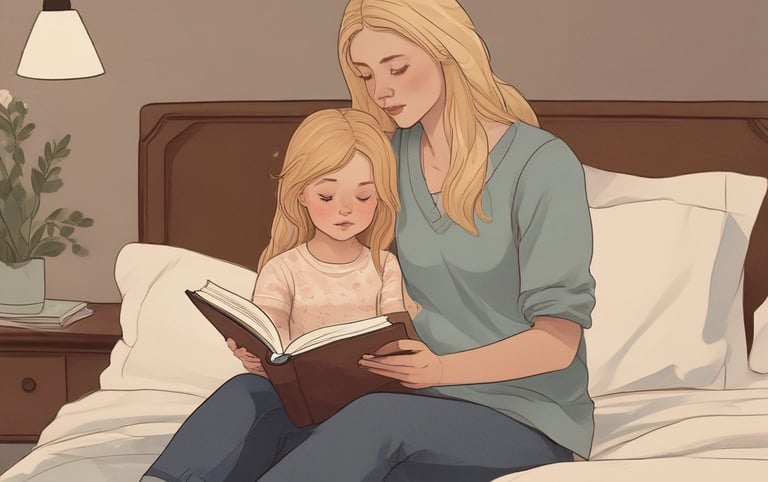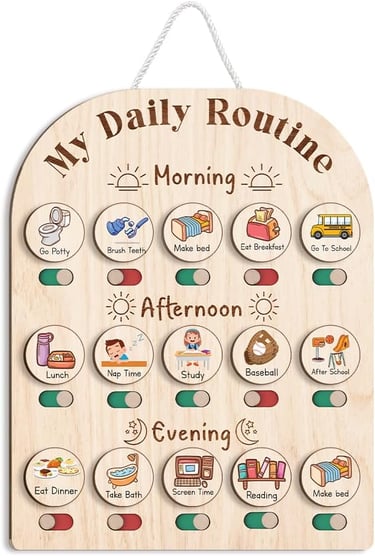How to Support Your Child with Anxiety: A Parent's Guide to Calm
PARENTING


Understanding Anxiety: What’s Happening in Your Child’s Brain
At its core, anxiety is the body’s natural response to perceived danger. When a child feels anxious, their brain activates the fight-or-flight response, flooding the body with stress hormones like cortisol and adrenaline. While this response is essential for survival, in children with anxiety, it’s often triggered by everyday situations that aren’t truly dangerous, such as speaking in class, separating from a parent, or trying something new.
In the anxious brain:
The amygdala, the brain's fear center, becomes overactive, detecting threats that aren’t there.
The prefrontal cortex, responsible for logical thinking and decision-making, is less engaged, making it harder for your child to rationalize their fears.
This biological response explains why anxious children often react strongly to situations that seem manageable to others. They’re not being dramatic or difficult—their brains are genuinely stuck in overdrive.
Anxiety in children is more common than we often realize, yet it can feel overwhelming when it’s your child who is struggling. As parents, we want nothing more than to ease their worries and help them navigate the world with confidence. But anxiety isn’t something we can “fix” overnight—it’s a complex interplay of biology, environment, and learned behaviors.
The good news? There’s a lot we can do to support our children. This guide will help you understand the science behind anxiety, recognize common signs, and offer practical, evidence-based strategies grounded in Cognitive Behavioral Therapy (CBT) that you can use at home to foster calm and resilience.
Signs of Anxiety in Children
Anxiety can show up in many ways, and it doesn’t always look like worry or fear. Here are some common behaviors that may indicate your child is struggling with anxiety:
Emotional Signs:
Excessive fear or worry about specific situations (e.g., school, social interactions, or health).
Trouble separating from caregivers, even in familiar environments.
Frequent meltdowns or difficulty calming down after being upset.
Physical Signs:
Complaints of stomachaches, headaches, or other physical discomfort with no clear medical cause.
Difficulty sleeping, frequent nightmares, or reluctance to go to bed.
Restlessness or fidgeting, such as tapping fingers or picking at skin.
Behavioral Signs:
Avoidance of certain situations (e.g., refusing to go to school, avoiding birthday parties).
Seeking constant reassurance (“Will I be okay?” “Are you sure nothing bad will happen?”).
Irritability or becoming easily frustrated over minor issues.
Why Anxiety Persists: The Role of Avoidance
One of the key ways anxiety maintains its grip is through avoidance. When a child avoids a situation that makes them anxious—whether it’s talking to a new friend or walking into a noisy classroom—they feel immediate relief. However, this relief reinforces the idea that the situation was dangerous and should be avoided again in the future. Over time, avoidance can shrink their world, making even everyday tasks feel insurmountable.
How Parents Can Help: Strategies for Supporting Your Anxious Child
1. Create a Safe, Predictable Environment
Children with anxiety thrive on routine and predictability. A consistent schedule helps reduce uncertainty, which is often a trigger for anxiety.
Let your child know what to expect by discussing plans in advance.
Use visual aids, like calendars or checklists, to help them feel more in control.
2. Validate Their Feelings Without Reinforcing Fears
When your child expresses anxiety, it’s tempting to say, “There’s nothing to worry about!” However, dismissing their feelings can make them feel unheard. Instead, acknowledge their emotions while gently challenging their fears.
What to Say: “I can see that this is really hard for you. Let’s figure out how we can handle it together.”
Avoid over-reassuring, which can inadvertently reinforce their need for constant comfort.
3. Teach Them About Anxiety
Help your child understand what’s happening in their brain and body when they feel anxious. When they know that their fast heartbeat or sweaty palms are just signs of their fight-or-flight response, it can make their anxiety feel less scary.
Use Metaphors: Explain anxiety as an “alarm system” that sometimes goes off when it doesn’t need to.
4. Practice Gradual Exposure
One of the most effective CBT techniques for anxiety is gradual exposure. This involves helping your child face their fears step by step, starting with situations that feel only mildly challenging and building up to more difficult ones.
Example:
If your child is afraid of dogs, start by looking at pictures of dogs together.
Progress to standing at a distance from a dog on a leash.
Eventually, work up to petting a calm, friendly dog.
Exposure helps retrain the brain to recognize that the feared situation isn’t dangerous.
5. Encourage “Brave” Behavior
Praise and reinforce efforts to face fears, even if the outcome isn’t perfect. Celebrating small wins builds your child’s confidence.
What to Say: “I’m so proud of you for raising your hand in class today. That was brave!”
6. Model Healthy Coping Skills
Children learn by watching their parents. If you manage stress with healthy strategies, such as deep breathing, problem-solving, or asking for help, your child is more likely to adopt those behaviors.
7. Introduce Calm-Down Tools
Give your child practical tools to calm their body and mind when anxiety strikes.
Breathing Techniques: Teach belly breathing—inhale deeply through the nose for 4 counts, hold for 2 counts, and exhale through the mouth for 6 counts.
Grounding Exercises: Have them name five things they can see, four things they can touch, three things they can hear, two things they can smell, and one thing they can taste.
Creative Outlets: Drawing, journaling, or playing with sensory toys can help them process emotions.
8. Limit Avoidance While Offering Support
Encourage your child to face challenges rather than avoid them, but don’t force them into situations they’re not ready for. Strike a balance between being supportive and gently pushing them out of their comfort zone.
When to Seek Professional Help
While many children benefit from home-based strategies, others may need additional support from a mental health professional. Consider seeking help if:
Your child’s anxiety significantly interferes with their daily life (e.g., refusing to go to school).
They experience frequent panic attacks.
Their anxiety doesn’t improve with time or your efforts at home.
Round-Up: Key Takeaways
Anxiety is a natural response but can become overwhelming when the brain misinterprets everyday situations as threats.
Common signs include physical symptoms, avoidance behaviors, and excessive worry.
Parents can support their child by validating feelings, teaching coping skills, and encouraging gradual exposure to fears.
Professional help, such as CBT, may be needed for persistent or severe anxiety.
Conclusion: A Journey of Support and Growth
Supporting a child with anxiety isn’t about “fixing” them—it’s about walking alongside them as they learn to navigate their fears. By creating a safe, predictable environment, teaching them coping tools, and celebrating their bravery, you can empower your child to face challenges with resilience and confidence.
Remember, progress takes time, but every small step is a victory. Together, you and your child can build a foundation of calm, connection, and strength.








Willow & Linen
Embrace slow living and create cozy moments.
let's stay in touch
© 2024. All rights reserved.


